"Dobby--crouch!"
Aug 29, 2009
On a couch or a soft carpet, Dobby the dog is pretty good about sitting on command. But on a hard floor? He'll make a show of pretending, as shown here with Emily and Joshua Wiggin, who are very good at kneeling.

Aug 29, 2009
On a couch or a soft carpet, Dobby the dog is pretty good about sitting on command. But on a hard floor? He'll make a show of pretending, as shown here with Emily and Joshua Wiggin, who are very good at kneeling.

Aug 25, 2009
Hank jumps off the bannister into space. He is falling faster than a cellphone camera shutter can click.
I wasn't around when this picture was taken, and I know absolutely nothing about the landing. But the date on the digital photo file is 2007, so it must have all worked out.

Aug 24, 2009
During World War II, the shores of Casco Bay were heavily fortified, and the entrance to Portland harbor was mined. In 1942, a German U-boat was identified in the bay by a Civil Air Patrol pilot, but it got away before military aircraft arrived on the scene.
That's Portland Head Light in the distance, as viewed from the rusting remnants of the fortification on what is now the campus of Southern Maine Community College in South Portland.
Sep 19, 2009
The rocks are 400 million years old, give or take.
The photo is five years old.
The occasion was the birthday gathering on Peaks Island in Maine in honor of Bob Horowitz--my father, and the grandfather of these fellows--who was then 80 years old.
There's one obvious constant through all these years: some of us hominids are hard-wired to build forts and weapons and stuff out of rocks or whatever is close to hand.
Not as obvious, perhaps, but just as constant: some of us are hard-wired to knock down other people's forts and stuff. Hank recalls that he had to rebuild this whole structure all by himself. Had to.
My father will be 85 this next week. He's well beyond the stone age; most days, he aims for the Big Band era.
Left to right: Brothers Ted, Hank, Allen, and Joe Stein, with cousin Nick Horowitz.
Sep 28, 2009
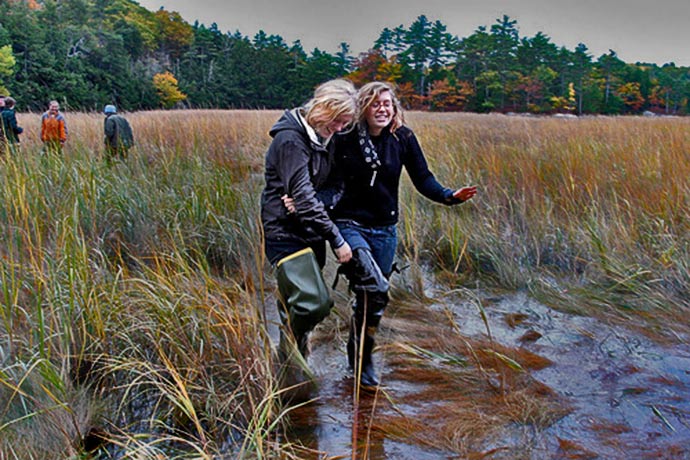
You know how it goes: one person slips in the marsh mud, and then the other person tries to help her up and loses her balance and slips in herself, and then the first one reaches out to grab the other one's arm and falls in even deeper. And soon enough, they and everybody else on the marsh that day have laughed till they couldn't laugh any more, till tears were spilling down their cheeks.
All this fun happened last fall to Schuyler Rowe and Addie Nammoun, in the salt marsh on Chewonki Neck, in midcoast Maine. Even today, just thinking about those girls in that marsh brings tears to the eyes of everyone fortunate enough to have been a witness. Schuyler keeps this photo as the desktop image on her laptop.
Sep 24, 2009
Carol Stack, of North Carolina, and Azaria Galli, of Maine, who have friends in common, recently shared a pizza at Flatbread's on the waterfront in Portland.
Sep 26, 2009

I triple dogg dare you, sez the writing on the lightpole.
Sep 30, 2009
If you send mail to this guy in New Gloucester, Maine, presumably it will be delivered here.
Oct 5, 2009
After October 1 each year, admission to Maine's state parks is free. On October 2, several classes from Helena Dyer Elementary School in South Portland took a field trip to Bradbury Mountain State Park in Pownal.
The children and teachers spread across the sunny bald at the top of the mountain to eat lunch, listen to stories, enjoy the view, and of course complete worksheets.. These boys claimed a rock of their own at the edge of the mountaintop; one of them insisted that his last year's teacher had said it was okay to sit there. Before this year's teacher could say no, two of them were up on the rock and the third had pulled out a camera to record their moment of boldness.
This year's teacher did eventually approve their place on the rock. Let's hear it for teachers with steady nerves who take children up to the top of a mountain in October!
Oct 8, 2009
Portland photographer Corey Templeton took this picture last summer. He says the staircase is somewhere in the West End.
Oct 9, 2009
Deep in the middle of the forest, far, far away from all the houses in the village, there was a tiny little farm with a big red barn.
Oct 13, 2009
The Outdoors Club from Deering High School spent Columbus Day weekend camping at Acadia National Park and climbing the cliffs on Mount Desert Island. Here, Hank inches his way up a crack.
Oct 22, 2009
Ninety-eight winters of salt have done a number on the mortar that was supposed to be holding the bricks together on my front steps. Fortunately, I count among my good friends an experienced bricklayer who was willing to take on the project. Here you see Katrin Maldre chipping away at the old mortar, using my little old rock hammer and a fancy new chisel.
To be fair, Katrin's bricklaying experience was not extensive or recent. But one summer back in Communist times, when she was growing up in Estonia, she and her friends were sent out into the country to work on a large brick construction project. Mostly, they moved bricks to and from piles---but it's a whole lot more bricklaying experience than I can claim.. (Katrin also has a son who has an engineering degree and knows about bricks and stuff, and who was willing to supervise this project from Estonia via Skype.)
Within an hour or two we got rid of most of the old mortar, slathered the free bricks with new mortar, and set them back in place. We broke one brick, and when the job was finished we somehow had an extra piece of brick left over. But you can't tell by looking at it.
The highlight of the job was definitely the new chisel. Note that yellow foam hand protector thing. Worth its weight in gold! Its inventor is a genius.
Oct 27, 2009
This is the second most stunning bit of fall on my street. It's a cherry tree I planted when we first moved into this house, and it's big enough now that I could stand underneath the branches and take this picture aiming up at the sky through a crown of glowing leaves. The picture is not turned sideways; the branches just branch off one another that way.
The first most stunning bit of fall on my street is a hydrangea down the block with leaves as pink as the flowers. I hope to get a shot of it, but in the meantime . . . you don't have to take my word for it; you can imagine it however you want.
As Octobers go, this one was so too wet to be entirely pleasant. But perhaps because of all the rain, a lot of leaves are still hanging in there. Then too, the few blue-sky days have been all the more precious.
Oct 29, 2009
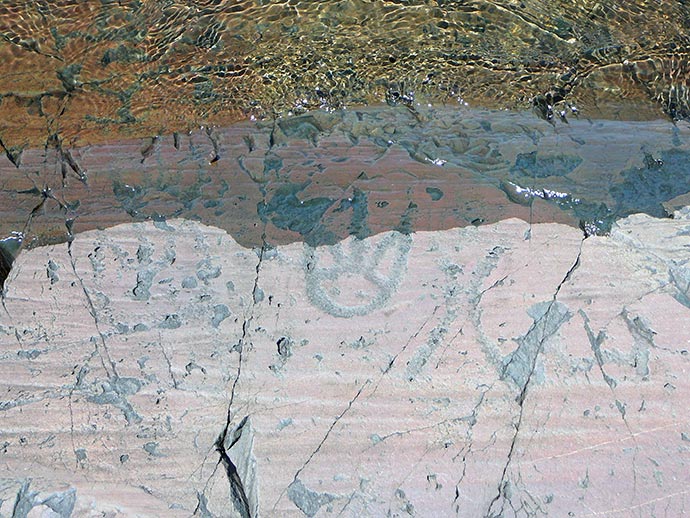
At low tide, you can paddle a boat out into Machias Bay, way downeast in Maine, to get a look at Native American petroglyphs that are hundreds or thousands of years old.
Passamaquoddy and Maleseet Indians drew pictures on bedrock outcroppings near the bay by pecking at the rock with sharp pieces of harder rock. About 500 drawings in 9 sites are known today.
Some of the meanings are obvious, such as the drawing of a deer at a spot near Machias Falls where deer can often be seen to this day. Other images are believed to reflect visionary experience, in which birds, for example, may be interpreted as messengers from afar.
Cultural style and probably age of the petroglyphs seem to vary. Some may be only 400 years old, while others are thought to have been created more than 3,000 years ago.
Most of the Machias petroglyphs are now under water except perhaps at lowest tide. The petroglyphs were probably created on land near the shore of the bay and its islands because that's where the largest exposures of bare rock would be found; unfortunately, sea level has been rising ialong the Maine coast ever since the end of the last Ice Age.
Nov 1, 2009
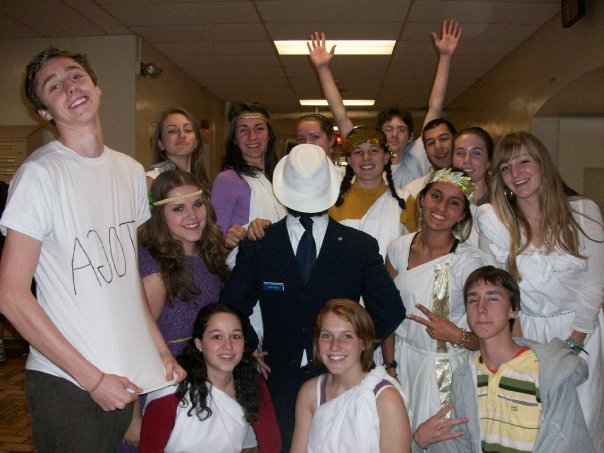
Every day had a theme during Spirit Week at Deering High School. There was '80s Day, Mainer Day, and then Toga Day. But the school administration had second thoughts about Toga Day--What if those stupid kids didn't wear enough clothes underneath their "togas"? At the last minute, Toga Day was called off, to be replaced by Backwards Day. Most students chose to not get the message about the late change in plans, and they came to school dressed pretty much as the administrators had feared. Our own Hank Stein, however, chose to observe Backwards Day, all decked out in his Senate page uniform.
The seniors who were eventually elected 2009 Homecoming Queen and King are both in the toga picture. The queen, Mohdis, already has a crown, and the king, Jacob, is wearing a t-shirt labeled "toga."
At the end of Spirit Week, the homecoming football game on Friday night could have gone better; Deering got trounced by Cheverus. But I am told that the dance on Saturday night was just fine. In the picture here from a pre-dance party and photo session, Hank is once again right in the middle of everything, but this time in a black shirt and white tie.

Nov 7, 2009
Winter is sneaking up on us fast--in fact, these last couple of days here have left the impression that it's done snuck up already, and snagged us in its clutches. Anyway, here are a last couple of fall pictures, from last month. The first one is of Rye Beach, New Hampshire, by Tanja Baker. The other one shows a hydrangea bush on my street in Portland.
Nov 10, 2009

Old-school deadheads are logs that sank to the bottom of a river or lake during the logging drives of the last century or the century before that or even the century before that. Before the railroads reached the northwoods, loggers went out in the forests every winter, cut down the trees with axes or cross-cut saws, and dragged the logs down to the banks of the nearest river. Come spring, they would drive the logs downriver to saw mills or later paper mills.
The log drives were operated every spring in Maine from the 1770s until the mid-twentieth century, especially on the Penobscot River, which became the most important logging river in the world, transporting hundreds of millions of board feet of lumber every year to the mills in Bangor. When the Penobscot was high and water was running fast,, logs piled up in dangerous logjams. When water was low, the logs slowed and beached themselves on the rocks. Either way, inevitably, some logs became waterlogged and sank.
Down at the bottom, logs eventually lose their bark and become slimy, but the wood is perfectly preserved in cold water and can be dried out and used for anything. While millions of logs are streaming by on top of the water, it is not economical to salvage the deadheads at the bottom. Today, the economics are different.
If you want to cut standing timber on state-owned land, you have to pay the state about 40% of the estimated value of the lumber you will sell. If you want to salvage deadheads from a lake or river in Maine, you'll have to pay 20% of the lumber value. This year, two underwater logging operations tried to make a go of it in the state.
They use pontoon boats equipped with fish-finders, which have no trouble locating the logs. The guy working Moosehead Lake irigged up a mechanical deadhead retrieval system with grappling hooks and winches. The guy working the Penobscot River dives with scuba equipment to snag the logs for his winch. Either way, on a good day, they might bring up six or eight logs, lash them to the pontoons, and haul them to shore, where they'll eventually be carried by truck to a sawmill. The process is time-consuming, and it's not cheap, but the wood is of a quality that is no longer available in standing forests--old-growth lumber, sometimes two or three feet in diameter, with the close-packed growth rings reflecting slow centuries of maturation.
The ecological issues are tough. On the one hand, after decades or centuries underwater, the deadheads have developed a niche of their own in the riparian ecosystem, feeding insects with their bark and sheltering baby fish.. Also, the logs cannot be removed without stirring up a lot of sediment and disrupting all the critters in the water. On the other hand, the more salvaged lumber we use, the fewer new trees we'll have to cut.
This picture is a still from a newsreel about diving for logs in the Penobscot.
Dec 26, 2009
To be more precise: at least one mitten came off late in the afternoon of Christmas day when Hank and Al had at it on the bluff above Kettle Cove, on the nearly snowless southern coast of Maine. It wasn't a real fight, just a little sibling rasslery.
Jan 10, 2010
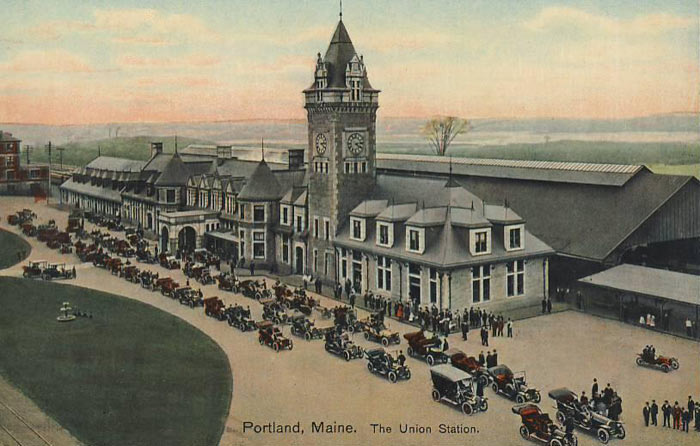

The Grand Trunk Line went bankrupt in 1920. Cost overruns on its expansion to the West Coast stressed the company, and its route planning out west proved unfortunate, too far north to compete with the fledgling Canadian National Railroad, which eventually absorbed it. The Grand Trunk's U.S. lines were assigned to a holding company that used the Grand Trunk name, but they too declined and faded in the mid-twentieth century along with the railroad industry in general.
The Grand Trunk station in Portland, on India Street near the waterfront, was demolished in 1948. These pictures actually show a different Portland train station, Union Station on Congress Street near St. John Street, which handled southbound passengers and freight. Union Station opened in 1911 and was demolished in the1960s to make way for the I-295 highway.
Portland lost an elegant building that day--the current Amtrak station is basically just a corner of the bus station lobby--but by all accounts, the destruction awakened people to the importance of historic preservation. And though it couldn't have been foreseen in the 1960s, when urban renewal was thought to lead to future glory for America's cities, Portland's old buildings and cobblestone streets have turned out to be what saved this town--people have learned to make money off of "quaint."
Jan 17, 2010
The old Eastland Hotel in downtown Portland has a lot of windows and a lot of bricks.
Feb 16, 2010

School's out this week for February break, but there's basically no snow hereabouts for the kids to play in. For Joshua, Emily, and Andrew, a trip to the artificial snow at Seacoast Park in Windham, Maine, solved the problem neatly. The kids went tubing all day Monday, and came home to . . . a forecast for plenty of snow on Tuesday. Winter's coming back to northern New England; the rest of the country can relax now.
Mar 1, 2010
At Wilbur's Chocolate Factory in Freeport, Maine, there are no oompa loompas, and thus a need for some serious antique confectionary equipment. This machine carries melted chocolate straight up on a vertical conveyor belt with little hooks to snag the stickiness. At the top, the chocolate spills down a chute. At the bottom of the chute, some of it collects in a cup, where it cools a bit and thickens to a suitable consistency for hand-decorating the tops of candies with little squiggles; the rest spills between tiny rollers carrying a parade of naked candy centers in need of chocolate coating.
After they get their chocolate coats, the candies roll along into a little air conditioner, which chills them to room temperature in exactly seven minutes.
May 29, 2010
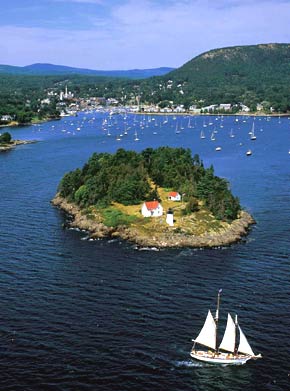
This birdseye view of the harbor at Camden tells the seasonal story all up and down the coast of Maine. The boats are back.
May 30, 2010
 For the kitchen table, Marion brought us lupine from her yard in Warren, Maine. Sharing the vase with the flowers are leaves of mint.
For the kitchen table, Marion brought us lupine from her yard in Warren, Maine. Sharing the vase with the flowers are leaves of mint.
Jun 3, 2010
The evening before graduation, seniors from Deering High School are skipping rocks on the cobble beach at Fort Williams Park in Cape Elizabeth, Maine.
Jun 4, 2010
Words on the wall at Fort Williams park, Cape Elizabeth, Maine.
Jun 23, 2010
Members of Deering High School's Outdoors Club head back down the hill and into the weather after summiting mile-high Mt. Katahdin recently, the highest peak in Maine and northern terminus of the Appalachian Trail.
As they followed the trail on down into the clouds, they got rained on but good. Fortunately, their youthful high spirits proved to be waterproof.
Jul 4, 2010
The water tank in Baldwin, Maine, has seen better days, but they still fly the flag on the Fourth of July.
Jul 17, 2010
 Used to be, the city of Portland would set aside a time in June when people could put big pieces of junk--such as unwanted furniture--out by the curb for city garbage trucks to collect. But there are no more Big Trash Days; the service was slashed as a budget-cutting measure. Although city residents are now expected to haul their own stuff to the dump, Jacob Powers found this resting spot a few weeks ago in a couch left out at the curb.
Used to be, the city of Portland would set aside a time in June when people could put big pieces of junk--such as unwanted furniture--out by the curb for city garbage trucks to collect. But there are no more Big Trash Days; the service was slashed as a budget-cutting measure. Although city residents are now expected to haul their own stuff to the dump, Jacob Powers found this resting spot a few weeks ago in a couch left out at the curb.
Nov 6, 2010
He turned eighteen the other day. Our work is done. He's up and away now.
Dec 1, 2010
Thanksgiving weekend was seasonably cold in Maine, so sipping coffee was among the smarter things to do at the beach.
Jan 9, 2011
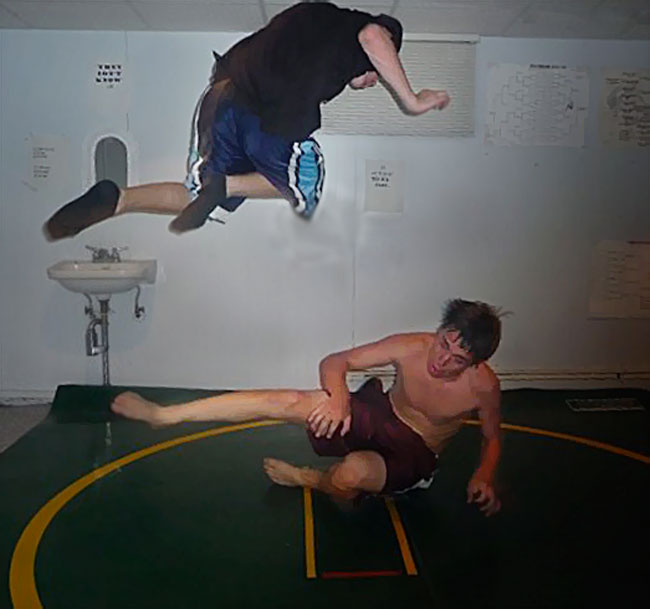
The kids used to have their friends over, and they'd go down in the basement and rassle and stuff. They're all grown up now, more or less; they're not living at home any more, and so we sold the house. Basement and all.
Jan 24, 2011
 Ferrets in their den, according to their mother. Groundhog Day comes next week.
Ferrets in their den, according to their mother. Groundhog Day comes next week.
Jul 19, 2011
 That's Pete, in his straw boater, as the eponym of Sandy Wilson's The Boy Friend, a sendup of 1920s-style song and dance.
That's Pete, in his straw boater, as the eponym of Sandy Wilson's The Boy Friend, a sendup of 1920s-style song and dance.
Waynflete staged the show as its 2011 spring musical. Although the production was well received, its three-night run was a bit shorter than that of the original production in London's West End, where it played for five years and more than 2,000 shows.
The Broadway production was also a hit, introducing Julie Andrews to American audiences. But in 1971, a film version of The Boy Friend–starring the fashion model Twiggy–earned critical acclaim but was a commercial disaster.
Aug 3, 2011
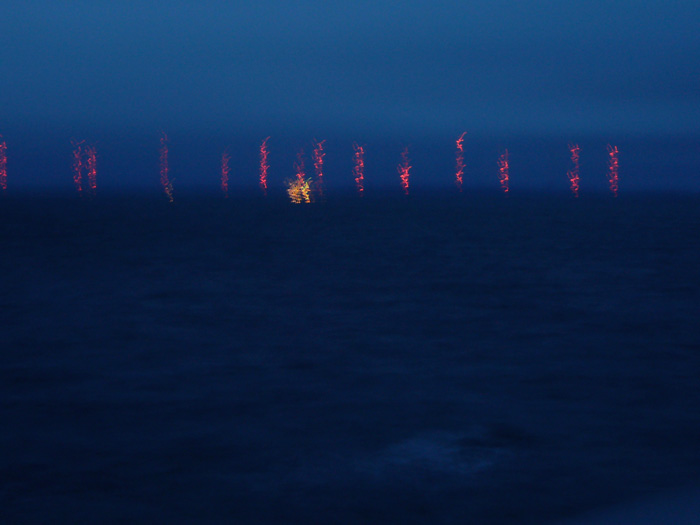 In hopes of maintaining secure communication with its ships and submarines at sea, no matter what, the U.S. Navy maintains arrays of thousand-foot-high Very Low Frequency transmitter towers at three locations around the world. This is the Navy's Cutler array, the largest and most powerful radio installation in the world, with 26 towers located on a peninsula at the edge of the Atlantic Ocean in downeast Maine, near Machias.
In hopes of maintaining secure communication with its ships and submarines at sea, no matter what, the U.S. Navy maintains arrays of thousand-foot-high Very Low Frequency transmitter towers at three locations around the world. This is the Navy's Cutler array, the largest and most powerful radio installation in the world, with 26 towers located on a peninsula at the edge of the Atlantic Ocean in downeast Maine, near Machias.
Cutler, constructed in 1961, is 100 percent Cold War technology: no GPS, no internet, no cellphone network. The biggest towers in the world were built here because this station services vessels in the Arctic Ocean as well as the Atlantic and Mediterranean, and naturally occuring electromagnetic pulses in the Arctic–the Aurora Borealis–can interfere with all but the most powerful radio signals.
The transmitters here run on power generated on-site and distributed to the towers by underground wiring. Underground wires also extend far offshore under the ocean, to maximize communication with submarines. There are no naval personnel working in Cutler; a civilian crew maintains the site, which sends out encrypted signals generated at a base in Norfolk, Virginia.
Although this shaky picture, which was taken with a handheld camera on a dark and cloudy night, suggests a somewhat haphazard string of towers, they are actually arranged in two identical clusters, which can operate separately or together. Each cluster can be shut down as necessary for maintenance. There's a problem, however, in the part of the installation around the power plant, where the two clusters are so close to one another that the electromagnetic field can be hazardous to humans, even when one of the clusters is shut down.
This area of the installation is called the Bowtie. People doing maintenance try to work as little as possible in the Bowtie, because even if they are working on towers that have been shut down they may still be exposed to dangerous electrical radiation from nearby still-active towers.
Because the Navy requires that at least one of the Cutler clusters must be functioning at all times, the towers in the Bowtie area of the installation have seen little maintenance over the years. In particular, they have never been painted, and they are now fifty years old. The civilians onsite requested a four-month shutdown of the entire array to complete the painting, but the Navy said no.
I predict one of two probable resolutions: either they'll run out of money for the paint job and just let the salt and snow do their thing on the thousand-foot towers, or else they'll redefine the safety standard for electromagnetic radiation so that working in the Bowtie magically becomes safe.
Can you get cellphone service on submarines?
Sep 8, 2011
The rhododendron that were blooming back in June, when we spent a week at a camp on Little Sebago Lake in Windham, Maine, are just a memory now. Marion P. grew the flowers and cut them for us and arranged them and even supplied the bucket.
Nov 24, 2011
 This Thanksgiving Day we 99-percenters might as well be grateful for football, a blessing as mixed as any but as American as . . . never mind. The postcard pictured here is from 1900
This Thanksgiving Day we 99-percenters might as well be grateful for football, a blessing as mixed as any but as American as . . . never mind. The postcard pictured here is from 1900
In Maine, Deering and Portland high schools have been facing off in their annual Turkey Bowl since 1911; the forecast for this hundredth annual game calls for clear skies, temperatures just below freezing, and a Deering victory, though you never can tell.
In Alabama, college football starts getting serious this weekend as LSU contronts Arkansas and Alabama has to deal with Auburn; if these games go according to book, LSU and Alabama will meet at New Year's for the national title, in a rematch of an October game that just didn't go right at all for Alabama.
I suppose that only the very smallest families in America could possibly all dine together at the same Thanksgiving table; our table, like so many others, will be missing important people this year, for all sorts of reasons. But we'll be thinking of them, and probably making fun of them, and we'll raise a glass and eat cranberries and maybe later if it's not too cold, some of us will go out in the street and throw a football around, because it's a free country or something like that.
Dec 19, 2011
 When this picture was taken, the Wiggin family had included Vera the dog for about two hours.
When this picture was taken, the Wiggin family had included Vera the dog for about two hours.
Dec 28, 2011
 The twins rolling around on the mat at lower left are imitating their father's winning wrestling moves at right, during Deering High School's annual alumni wrestling meet last week.
The twins rolling around on the mat at lower left are imitating their father's winning wrestling moves at right, during Deering High School's annual alumni wrestling meet last week.
For many alumni of Deering's storied wrestling program, this meet is their only chance to lace up their old wrestling shoes and see if they've still got what it takes. Coach Kirk, who's been running the show at Deering for more than thirty years, matches up each alumnus against a member of the current varsity squad; the wrestling is vigorous but not particularly intense, because Coach always rigs the matchups to favor the old guys. This year, as in most years, the alumni won every bout.
Jan 17, 2012
 Two winters ago around this time, when this picture was snapped, there was no snow along the southwest coast of Maine, though somehow the color of the water suggested some seriously shivery cold. This year, I understand that there's a bit of snow on the ground in Maine; here in Philadelphia, however, we've had only a flurry or two. It's raining as I type.
Two winters ago around this time, when this picture was snapped, there was no snow along the southwest coast of Maine, though somehow the color of the water suggested some seriously shivery cold. This year, I understand that there's a bit of snow on the ground in Maine; here in Philadelphia, however, we've had only a flurry or two. It's raining as I type.
This stretch of cliff near Kettle Cove in Cape Elizabeth, Maine, faces south more than east, allowing a glimpse of winter sunset over the water.
Feb 16, 2012
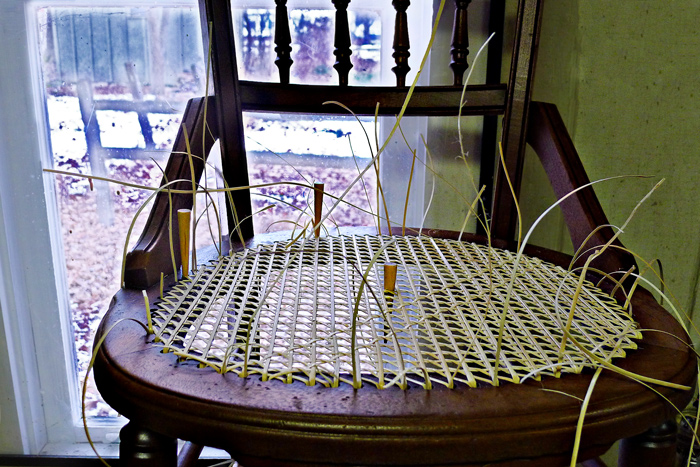 Another hour's work, and Bernard Zike will have the seat of this chair completely restored. People from all over New England bring worn-out old chairs to Bernard's workshops in Warren and Portland, Maine, where he and his partner, Marion Puglisi, work centuries-old caning and rushing techniques, often with reeds they've harvested themselves from local ponds.
Another hour's work, and Bernard Zike will have the seat of this chair completely restored. People from all over New England bring worn-out old chairs to Bernard's workshops in Warren and Portland, Maine, where he and his partner, Marion Puglisi, work centuries-old caning and rushing techniques, often with reeds they've harvested themselves from local ponds.
Would-be apprentices from all over the country seek them out in hopes of mastering the craft, though many will give up their dreams when they learn how much patience is required. After more than twenty-five years of experience with traditional tools and all kinds of natural seating, it still takes Bernard almost a full day of work to repair a single chair bottom.
This is one of Bernard and Marion's winter chairs; it will spend the winter in their shop. It belongs to some of Maine's summer people, who drop off broken chairs when they close up their summer homes in the fall, with the expectation that when they reopen their summer homes next spring, they can reclaim the chairs, and they'll be good as new.
Mar 28, 2012
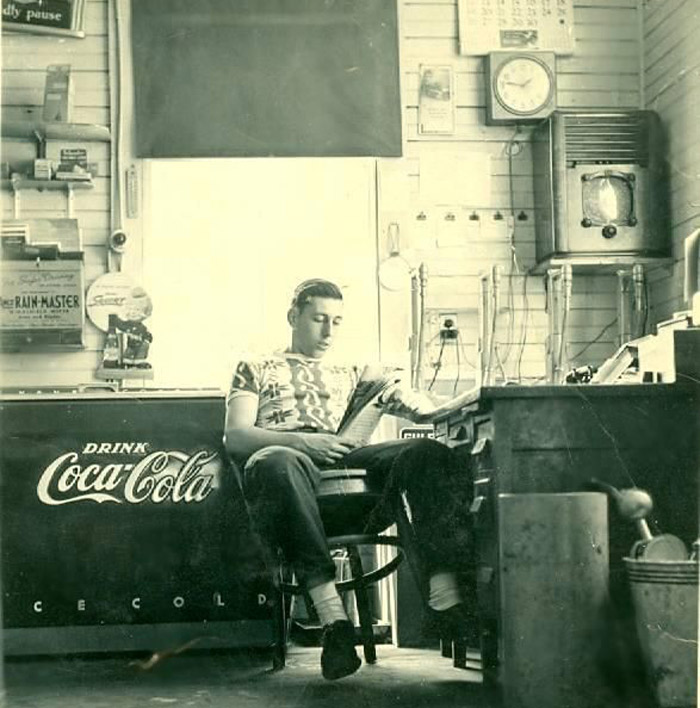 William Pinkerton, back in the day, hard at work at the dispatch desk at Bud Wood's taxi service in Rockland, Maine.
William Pinkerton, back in the day, hard at work at the dispatch desk at Bud Wood's taxi service in Rockland, Maine.
Apr 3, 2012
 Last week, in Portland, Maine, in the combined first- and second-grade class at Longfellow School, Emily Wiggin and her classmates made a mosaic table for a silent auction fundraiser. The winning bid on Saturday night was $200, and somehow, on Sunday morning, there was the table in the Wiggin living room.
Last week, in Portland, Maine, in the combined first- and second-grade class at Longfellow School, Emily Wiggin and her classmates made a mosaic table for a silent auction fundraiser. The winning bid on Saturday night was $200, and somehow, on Sunday morning, there was the table in the Wiggin living room.
Meanwhile, back in Philadelphia, kindergartner Lily Sklaver spent the week learning to ride her bike without training wheels or pedals; by last night, when she had that balancing thing under control, the pedals went back on and she took off flying down the street.

May 12, 2012
 For an overnight Girl Scout adventure, these young'uns were coached in singing and dancing by an older troop of Cadette scouts. Then they assembled their costumes from bags of stuff and put on a runway show. "Yes, my daughter is donning a cheetah bra and tiara," reports Susan Wiggin. "Very proud moment."
For an overnight Girl Scout adventure, these young'uns were coached in singing and dancing by an older troop of Cadette scouts. Then they assembled their costumes from bags of stuff and put on a runway show. "Yes, my daughter is donning a cheetah bra and tiara," reports Susan Wiggin. "Very proud moment."
Jun 11, 2012
 Ramon Toye, a 250-pound guard for the Southern Maine Raging Bulls football team, was out on the tarmac at the Portland airport this past weekend pulling really, really hard for about five or six seconds. Apparently, that's how long it takes a typical team of twenty-five determined individuals to pull a 127,520-pound cargo plane a distance of 12 feet, which is the timed challenge for this annual competition.
Ramon Toye, a 250-pound guard for the Southern Maine Raging Bulls football team, was out on the tarmac at the Portland airport this past weekend pulling really, really hard for about five or six seconds. Apparently, that's how long it takes a typical team of twenty-five determined individuals to pull a 127,520-pound cargo plane a distance of 12 feet, which is the timed challenge for this annual competition.
The Raging Bulls and a couple of dozen other teams--entrants included a bank, a church, a gym, the Scarborough Police Department, the Shipyard Brew Crew, and of course a chiropractic office--pull the plane as a fundraiser for the National Multiple Sclerosis Society.
In the fall, the Bulls play football in the AAA New England conference; last season they went 7-3, placing second behind Lowell in the Northern Division. The rest of the year they pull airplanes and participate in other community service activities.

Jul 8, 2012

Jul 13, 2012
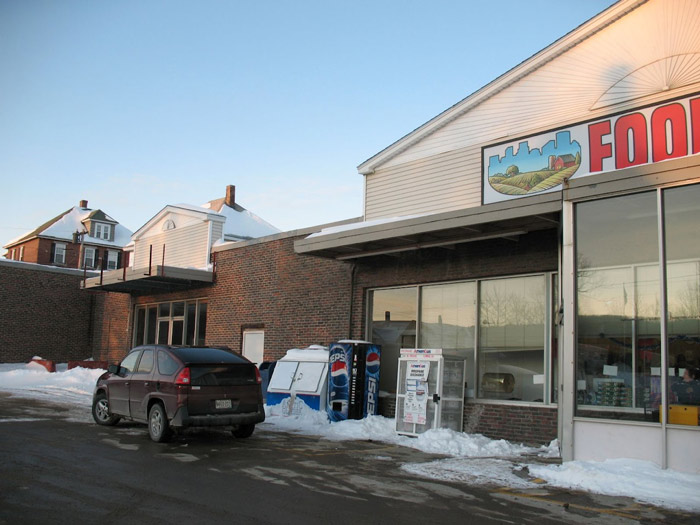 Yesterday, the scene at this Food City supermarket in Livermore Falls, Maine, looked a little different: all the snow was long gone, of course, but so was all the ice, including the ice from inside the double-doored cooler visible here in front of the store, where bags of cubes usually sit quietly frozen in summer as well as winter.
Yesterday, the scene at this Food City supermarket in Livermore Falls, Maine, looked a little different: all the snow was long gone, of course, but so was all the ice, including the ice from inside the double-doored cooler visible here in front of the store, where bags of cubes usually sit quietly frozen in summer as well as winter.
Overnight, someone broke into the ice chest and stole all 67 bags of ice inside. The ice was said to be worth about $75, with the damage to the cooler estimated at $250.
According to newspapers in Maine, the Livermore Falls police chief reported no suspects and not a clue as to motive.
Sep 3, 2012

Oct 23, 2012
 If it's October, there must be a pumpkin. This assemblage–which was first featured about four years ago in a predecessor to this here blog–dates back to the time when the brick steps in the photo led up to a house we lived in on Columbia Road in Portland, Maine. In addition to the pumpkin, the still life includes a non-blooming potted geranium and five quinces. The petrified tree stump, which is approximately 200 million years old, is something we found in an abandoned coal mine in Walker County, Alabama; it now sits near our back door in Philadelphia.
If it's October, there must be a pumpkin. This assemblage–which was first featured about four years ago in a predecessor to this here blog–dates back to the time when the brick steps in the photo led up to a house we lived in on Columbia Road in Portland, Maine. In addition to the pumpkin, the still life includes a non-blooming potted geranium and five quinces. The petrified tree stump, which is approximately 200 million years old, is something we found in an abandoned coal mine in Walker County, Alabama; it now sits near our back door in Philadelphia.